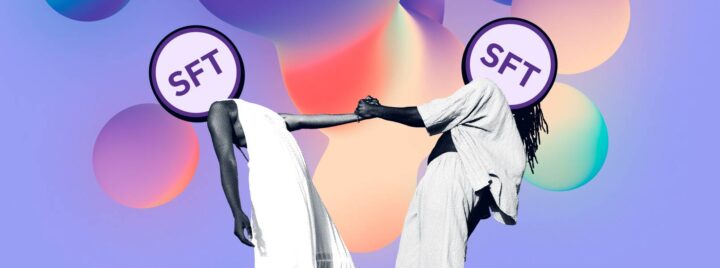SFT: What Are Semi-Fungible Tokens?

In the world of cryptocurrencies and blockchain technologies, a new form of digital assets continues to evolve, offering unique opportunities for users and investors — semi-fungible tokens (SFT).
Let’s break down what these are.

Key Features and Advantages of SFTs
A semi-fungible token (SFT) is a form of digital token that combines the features of non-fungible tokens (NFT) and fungible tokens, which encompass any cryptocurrencies.
SFTs have two key features:
- Unique characteristics. Each SFT can have its own unique metadata or attributes that set it apart from other tokens of the same type. This could include a unique identifier, ownership history, or other parameters. The token can be used beyond its native ecosystem as a unique asset.
- Fungibility. Despite having unique characteristics, an SFT can be exchanged for an equivalent token within its native ecosystem without losing value or functionality.
Among the main advantages of SFTs are:
- Liquidity. Due to fungibility, SFTs can be easily bought or sold, enhancing their liquidity in the market.
- Versatile use. SFTs can be utilized to create various financial instruments such as stablecoins, tokenized investment portfolios, or derivatives, providing users with more options for risk management.
- Enhanced asset management. Due to the unique parameters of each SFT, users can more effectively manage their digital assets and track their history and origin.
Overall, semi-fungible tokens represent an innovative technology that combines operational flexibility with the uniqueness of each token’s individual characteristics, opening up new possibilities for managing digital assets and introducing new scenarios for their use.

SFT Standards
SFTs were first created in 2018 by developers of blockchain platform Enjin. The semi-fungible token standard was used to create unique in-game items that could be freely exchanged within the gaming ecosystem. To this end, the first SFT standard on the Ethereum network, ERC-1155, was created. Among its major features are:
- Multiple token types. Several different token standards — ERC-20, ERC-721 and ERC-1155 — can be used within a single contract.
- Gas efficiency. The ERC-1155 standard enables batch creation and transfer of multiple tokens simultaneously, significantly reducing transaction fees.
- Support for atomic transactions. ERC-1155 allows recording a series of token manipulations within one transaction, ensuring the integrity and security of operations.
In the fall of 2022, another semi-fungible token standard was developed — ERC-3525. Similar to its predecessor, it combined the best properties of the ERC-20 and ERC-721 standards. The ERC-3525 standard considerably extended the NFT structure. Thus, two new features were added to the basic attribute id, which makes ERC-721 tokens unique:
- Slot, an attribute that allows tokens with identical attributes to be identified as the same token even though they have different id. For instance, bonds with the same slot parameters will be considered identical.
- Value, an attribute that determines the asset’s value. Through this parameter, the token can be divided into any number of equally valued parts.
The SFT standards ERC-1155 and ERC-3525 have found wide application in various fields, including the DeFi ecosystem, the gaming industry, and the tokenization sphere. With their implementation, developers gained the ability to create more flexible asset management systems, and users got access to new financial instruments, while the overall transparency of operations increased.
In early 2024, another semi-fungible token standard was proposed — ERC-404. Basically, developers improved the ERC-3525 standard to expand the liquidity of NFT collections. As of March 4, 2024, the Ethereum Foundation team hasn’t officially recognized the standard, so it’s experimental.

Practical Application of SFTs
Flexibility and programmability of SFTs allow for the creation of innovative products and services tailored to different user needs. Therefore, the practical application of semi-fungible tokens is growing every year.
Let’s take a look at the main ones.
Financial Apps
In financial applications, SFTs can be used to create various innovative financial instruments and services:
- Stablecoins with hybrid stabilization mechanisms. Stablecoins of this type can be backed by a combination of different assets, including cryptocurrencies, fiat currencies, gold, etc. These coins can use hybrid stabilization mechanisms, bringing together the advantages of fixed and algorithmic methods of maintaining exchange rate stability.
- Decentralized investment funds. The technology allows for the creation of DeFi systems where each token represents a share in a portfolio of assets. This simplifies investing in diverse assets and expands opportunities for capital management, diversification, and risk mitigation.
- Programmable derivatives. SFTs can be used to create programmable derivatives of financial assets whose smart contracts are automatically executed based on specific conditions or events.
- Liquid exchange protocols. On DEXs, trading pairs can be formed based on SFTs representing different assets. This allows users to perform direct exchange operations without intermediaries.
- Prediction markets. SFTs can be utilized in prediction systems to create market bets and contracts related to the outcome of events. Each token can represent a specific event or outcome, and users can trade them based on their predictions.
GameFi Industry
Semi-fungible tokens are actively used in different GameFi ecosystems. Functions of SFTs in games include:
- Creation of in-game items and assets.
- Collecting and trading.
- Rewards for in-game achievements.
Characters, weapons, resources, and any other virtual artifacts used in gameplay can be represented in the form of SFTs. These tokens can also be distributed as rewards for accomplishing specific tasks or achievements in competitions. Such assets can be used for participation in the management of decentralized gaming platforms and communities within individual projects. Moreover, they can be utilized within the broader Web3 ecosystem.
The use cases of SFTs in the GameFi industry are virtually unlimited, and the gradual development of semi-fungible token standards can significantly improve the gaming experience and bring innovation to the decentralized gaming sector.
Digital Rights and Content
Semi-fungible tokens find application in digital rights management systems, representing:
- Unique digital rights. Each token can embody a unique ownership document or content license, providing transparency and authenticity of rights.
- Copyrights and licenses. Authors can establish and control the terms of use and distribution of content realized as SFTs.
- Collection of digital artifacts. Each token can represent a unique piece of digital art with distinctive metadata and history.
- Subscriptions and content access. SFTs can represent access to platforms, services, or content, ensuring transparency and manageability of subscriptions.
Besides, SFTs can serve as the basis for creating decentralized digital content markets where creators and consumers can trade and exchange content without intermediaries.
All in all, the use of SFTs contributes to better copyright protection, transparency, and efficient content management. In this context, as well as in the gaming industry, the functions of SFTs duplicate the capabilities of non-fungible tokens, extending and complementing them. It’s precisely these extra use cases, compared to NFTs, that create the conditions for the further development and application of semi-fungible token technology in various areas of the Web3 industry.











